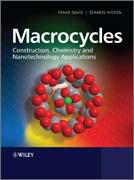
Macrocycles: construction, chemistry and nanotechnology applications
Higson, Seamus
Davis, Frank
INDICE: Preface. 1. Introduction. 1.1. Simple ring compounds. 1.2. Three dimensional aliphatic carbon structures. 1.3. Annulenes. 1.4. Multi-ring aromatic structures. 1.5. Porpyrins and phthalocanines. 1.6. Conclusions. References.2. Cyclophanes. 2.1. Introduction to cyclophanes. 2.2. Cyclophanes with one aromatic system and aliphatic chain. 2.3. Cyclophanes with more than 1 aromaticring. 2.4. Napthalenophanes and other aromatic systems. 2.5. Cyclophanes containing heteroaromatic systems. 2.6. Ferrocenophanes. References. 3. Crown ethers, cryptands and other compounds. 3.1. Introduction. 3.2. Crown ethers. 3.3. Simple complexes with crown ethers. 3.4. Azacrowns, cyclens and cyclams. 3.5. Crowns containing other heteroatoms. 3.6. Lariat and bibracchial crown ethers.3.7. Cryptands. 3.8. Spherands. 3.9. Combined and multiple systems. 3.10. Applications of crown ethers and related compounds. 3.11. Conclusions. References. 4. Calixarenes. 4.1. Introduction to calixarenes. 4.2. History of the calixarenes. 4.3. Structures of calixarenes. 4.4. Chemical modification of calixarenes. 4.5. Complexes with calixarenes. 4.6. Bis- and multicalixarenes. 4.7. Oxacalixarenes, azacalixarenes and thiacalixarenes. 4.8. Resorcinarenes - synthesis and structure. 4.9. Cavitands and carcerands. 4.10. Uses of calixarenes and conclusions. References. 5. Heterocalixarenes and calixnaphthalenes. 5.1. Introduction to heterocalixarenes and calixnaphthalenes. 5.2. Calixnaphthalenes. 5.3. Tropolone based macrocycles. 5.4. Calixfurans. 5.5. Calixpyrroles. 5.6. Calixindoles, calixpyridines and calixthiophenes. 5.7. Conclusions. References. 6. Cyclodextrins. 6.1. Introduction to cyclodextrins. 6.2. Complex formation by cyclodextrins. 6.3. Cyclodextrins of other sizes. 6.4. Modification reactions of cyclodextrins. 6.5. Selectivity of cyclodextrins. 6.6. Multiple cyclodextrin systems. 6.7. Polymeric cyclodextrins. 6.8. Cyclodextrins combined with other macrocyclic systems. 6.9. Therapeutic uses of cyclodextrins. 6.10. Other uses of cyclodextrins. 6.11. Conclusions. References. 7. Cyclotriveratylenes and cryptophanes. 7.1. Introduction to cyclotriveratrylenes and cryptophanes. 7.2. Synthesis of cyclotriveratrylenes. 7.3. Modification of cyclotriveratrylenes. 7.4. Synthesis of optically active cyclotriveratrylenes. 7.5. Modification of the bridging groups. 7.6. Modification of the aromatic rings with organometallic groups. 7.7. Selective binding applications of cyclotriveratrylenes. 7.8. Analogues of CTV. 7.9. Cryptophanes - synthesis and structure. 7.10. Cryptophanes - chemical modification. 7.11. Complexes with cryptophanes. 7.12. Cryptophane/Xenon complexes. 7.13. Other uses of cryptophanes. 7.14. Hemicryptophanes. 7.15. Conclusions. References. 8. Cucurbiturils. 8.1. Introduction to cucurbiturils. 8.2. Complexation behaviour of simple cucurbiturils. 8.3. Modification of cucurbiturils. 8.4. Uses of cucurbiturils. 8.5. Hemicucurbiturils. 8.6. Conclusions. References. 9. R
- ISBN: 978-0-470-71463-8
- Editorial: John Wiley & Sons
- Encuadernacion: Rústica
- Páginas: 640
- Fecha Publicación: 25/03/2011
- Nº Volúmenes: 1
- Idioma: Inglés
